Charles E W Bean, Diaries, AWM38 3DRL 606/271/1 - 1917 - 1938 - Part 7

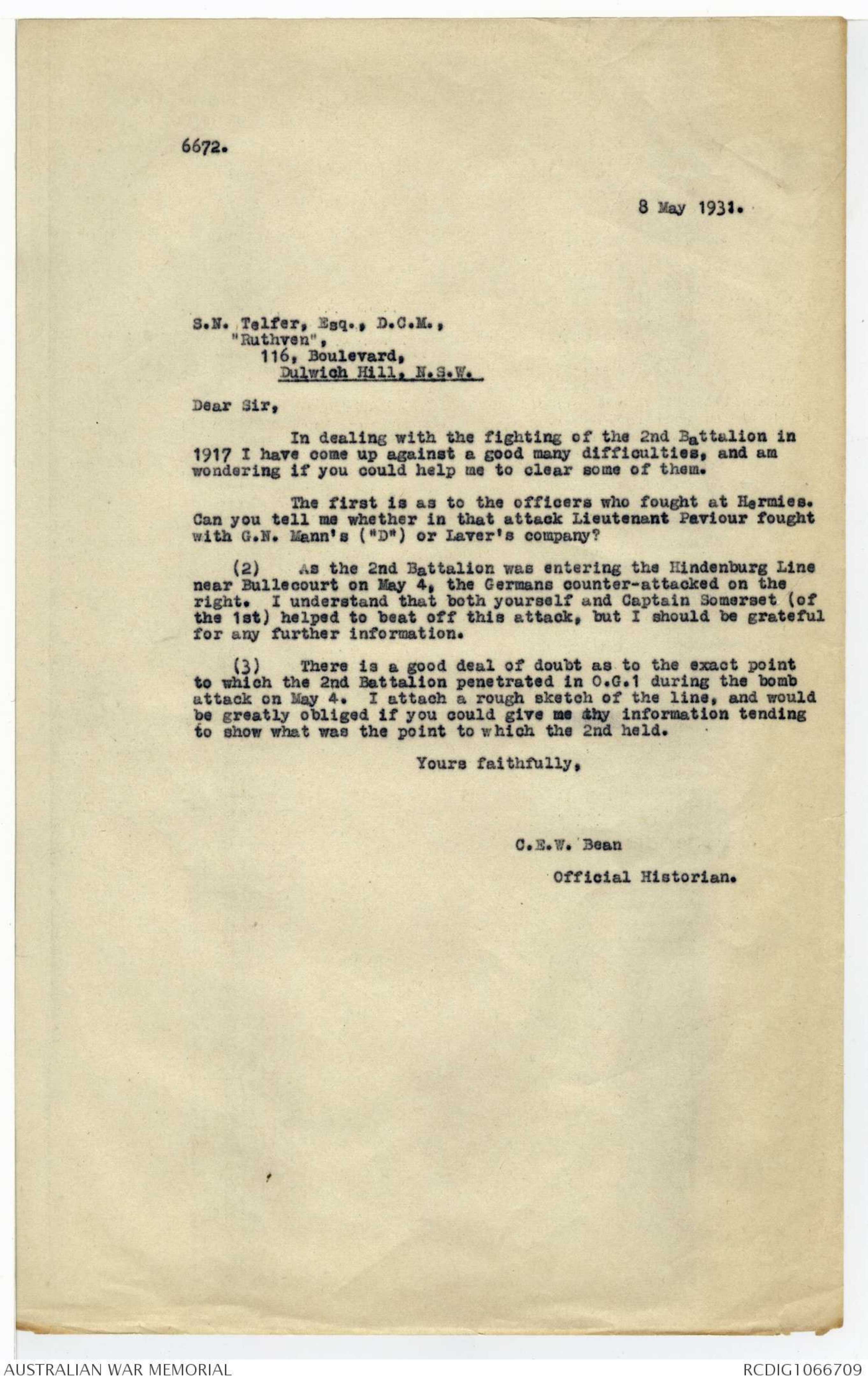
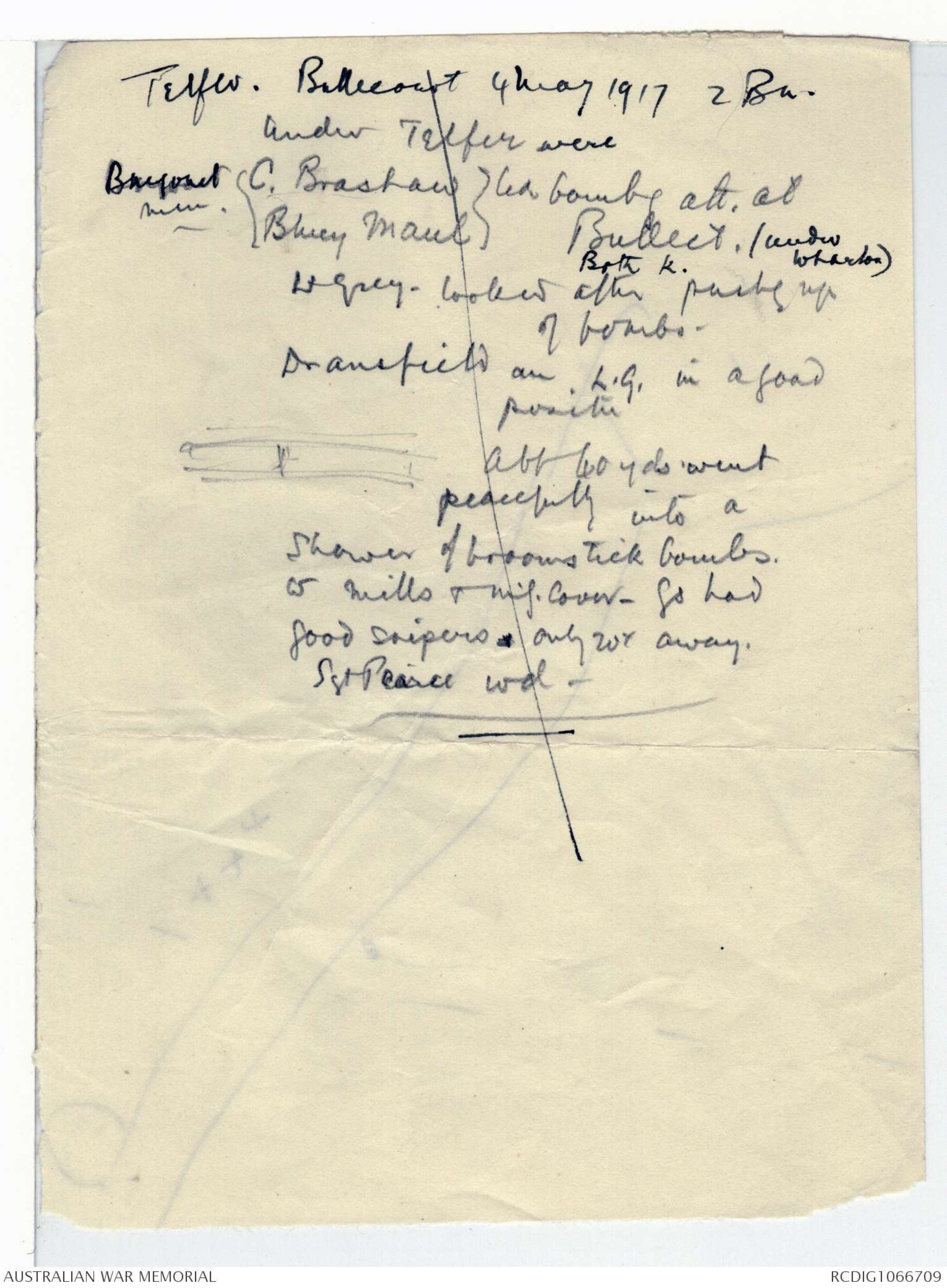
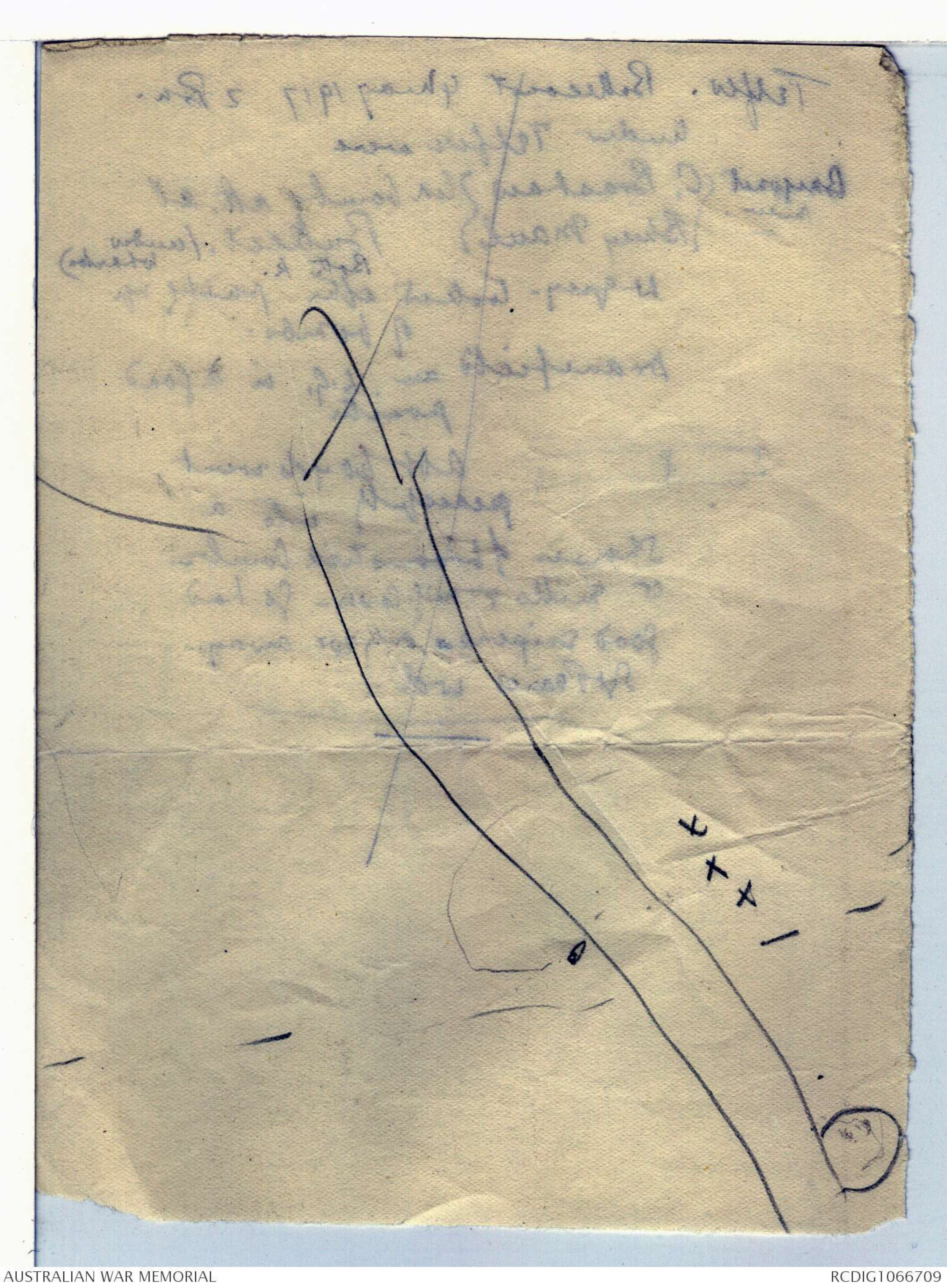
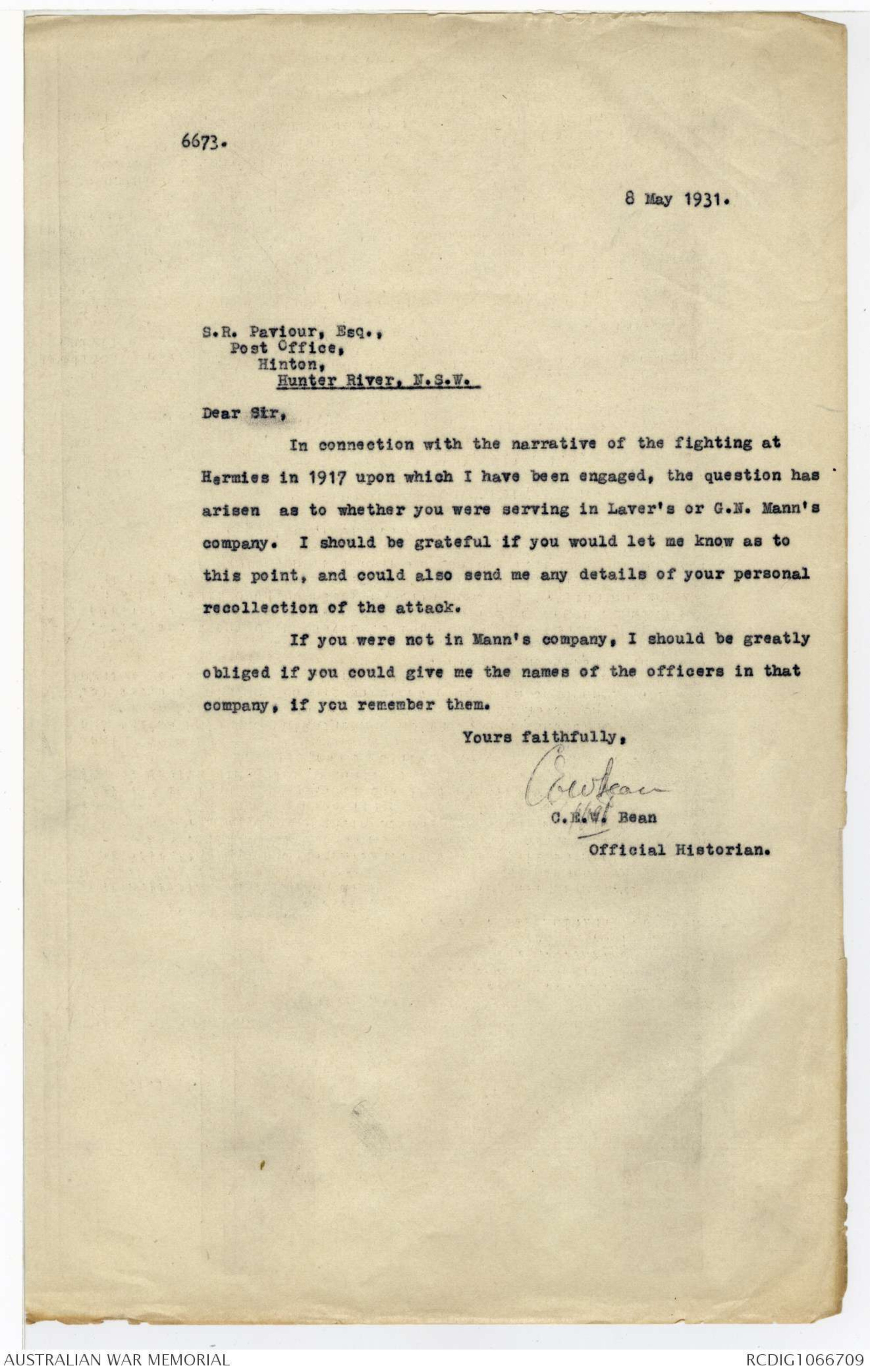
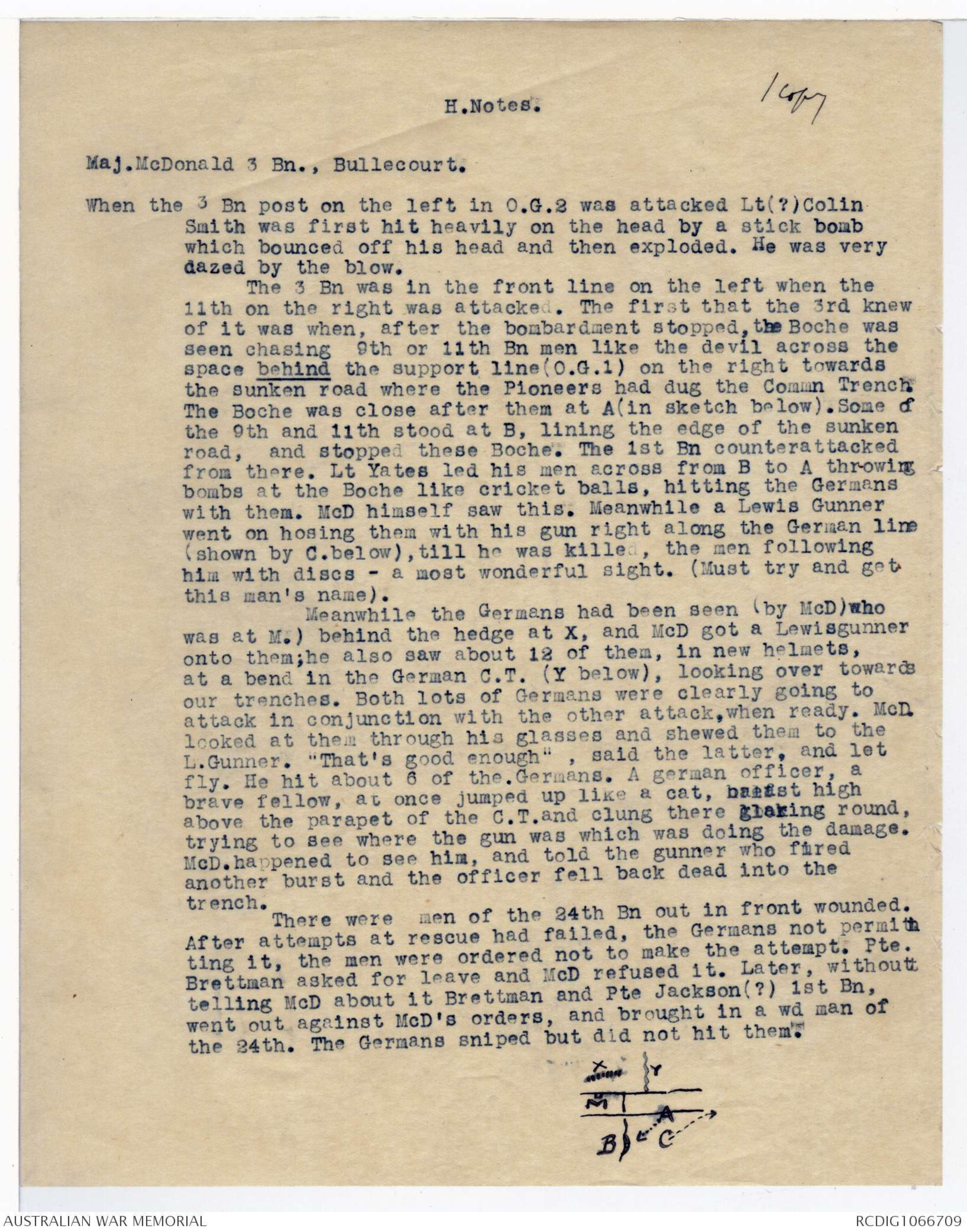
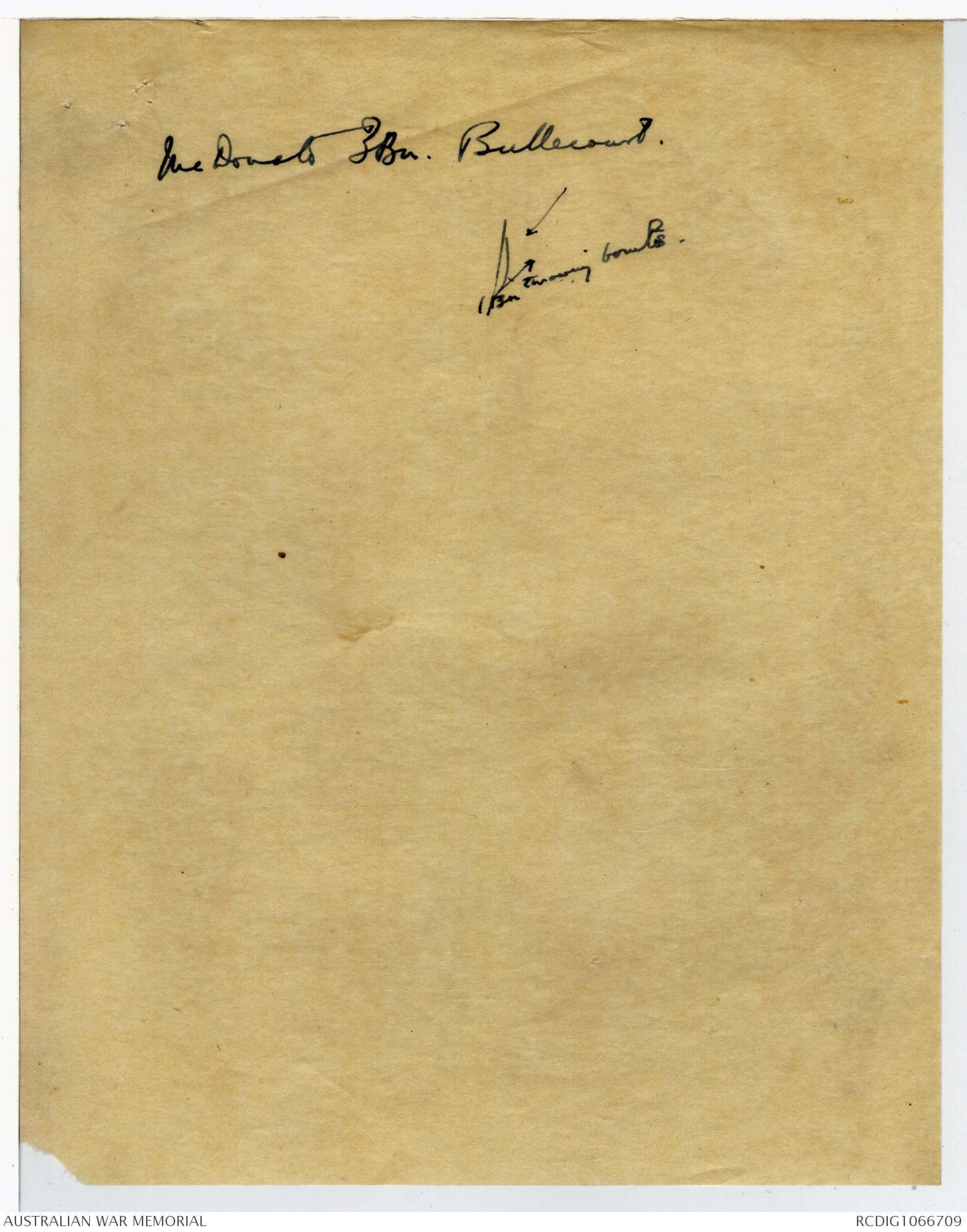
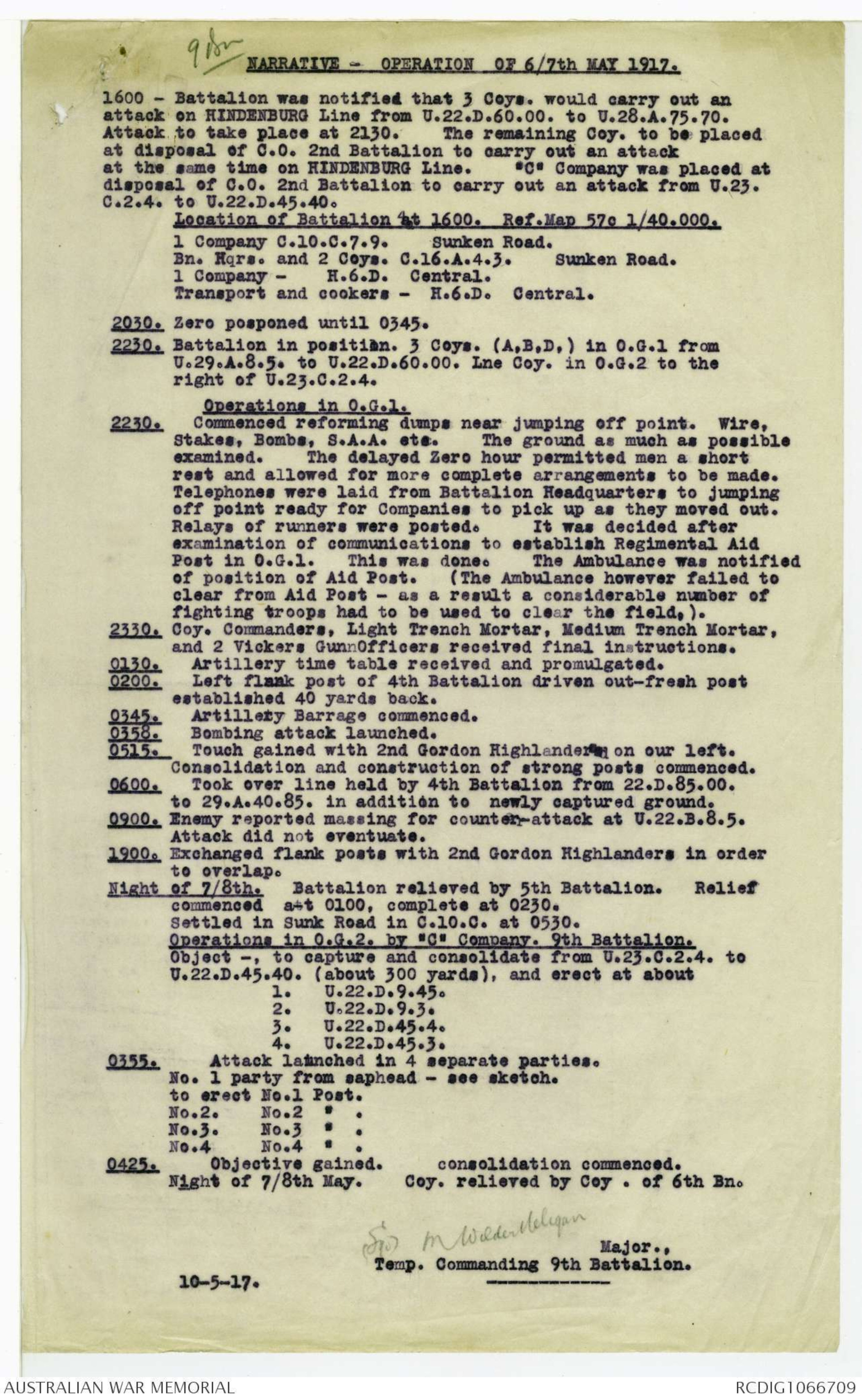
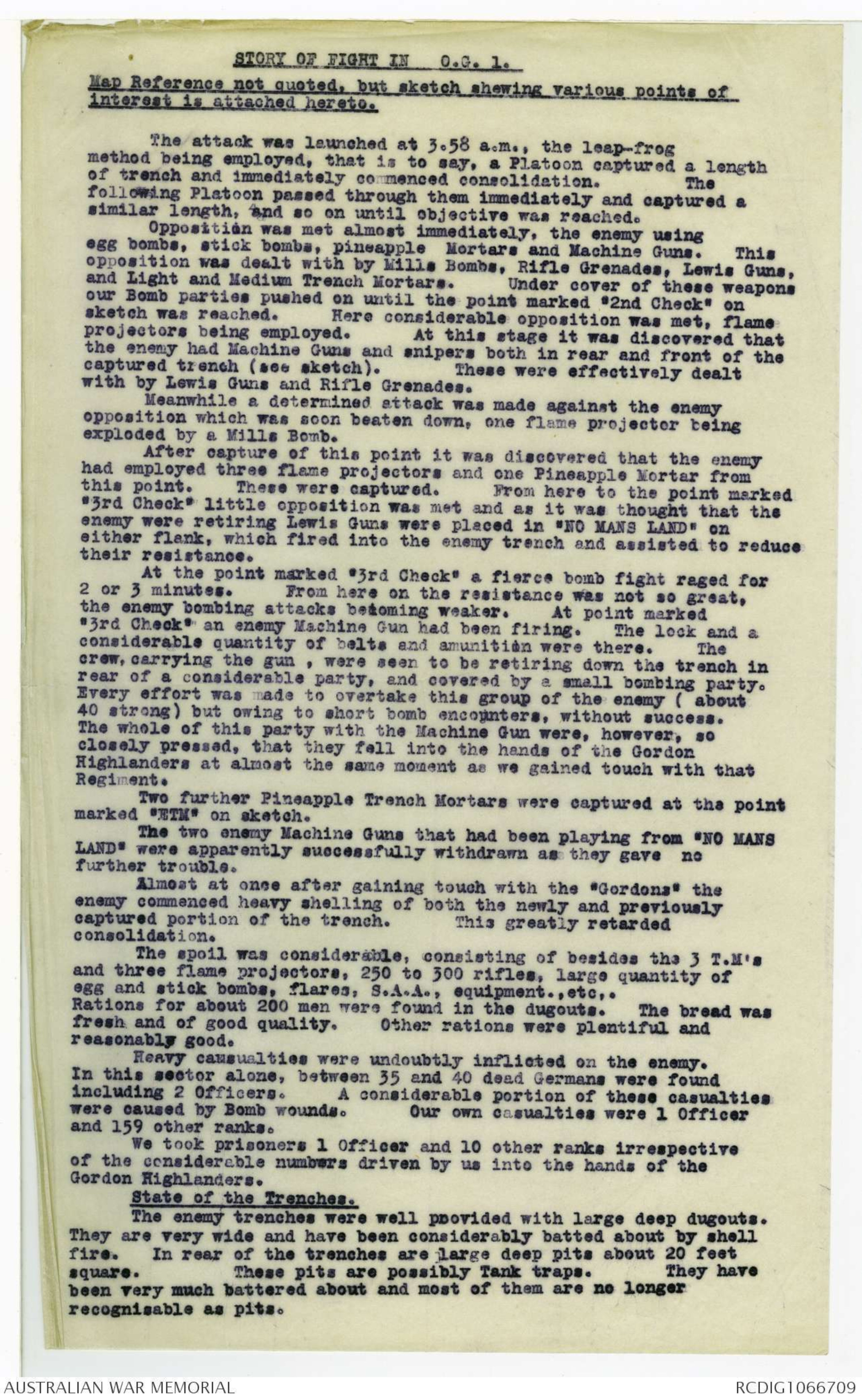
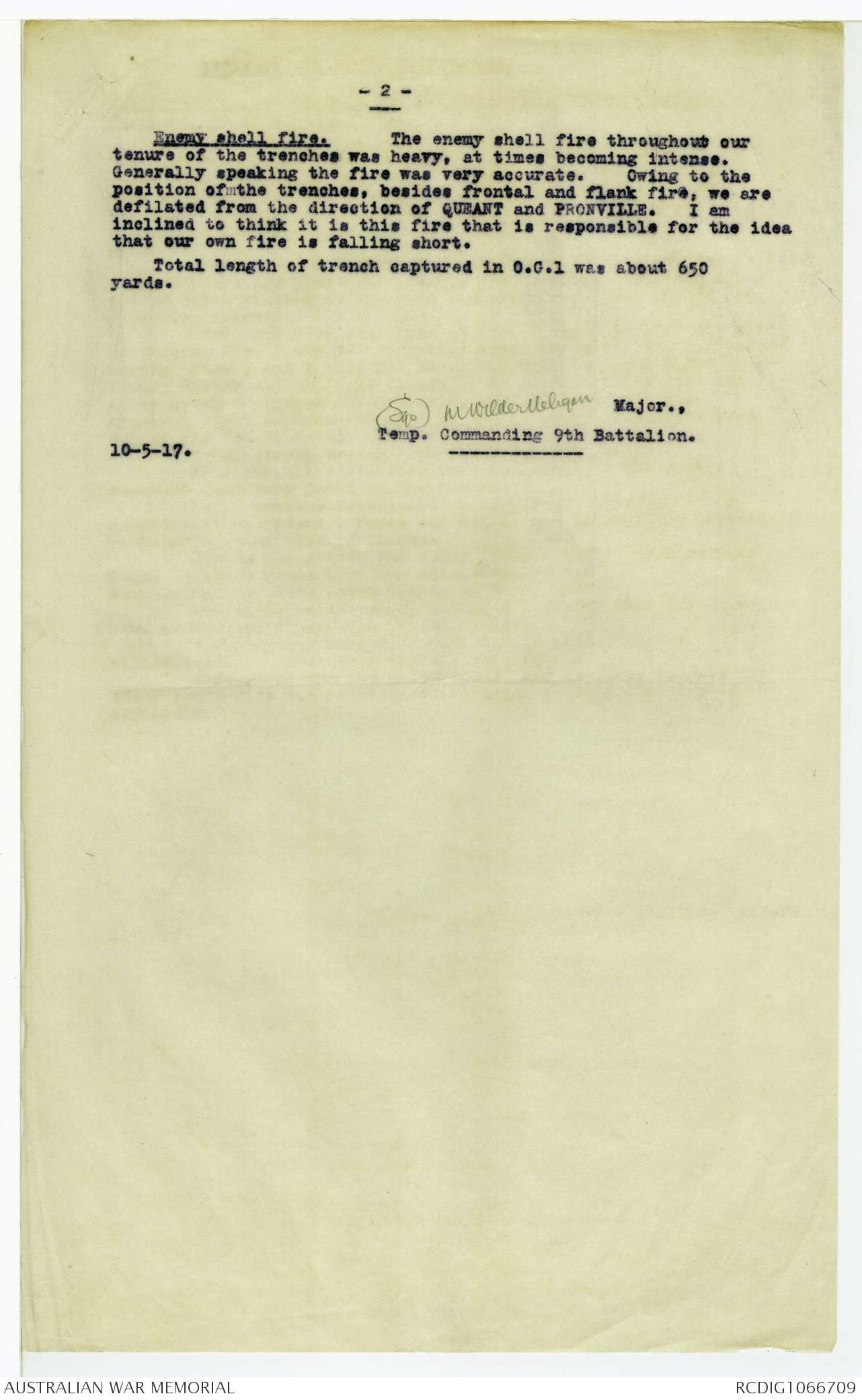
Lt Norris's Report:
Arrived in OG.1 at 3.30 am. Coy H.Q. at end of trench.
Bombers under Lt Wharton. (2 teams each supptd by ^a L.G. Team)
3.45. Sent Lt Wharton & a reconnoitring patrol along OG1. abt 80 yds.
Germans were localed here & attacked immediately with
a strong bombg pty, another party coming from rd. to Riencourt
where at xd the trenches.
Wharton sent one other rank to rept to Coy HQ. &
also to 1st Bn holding post between OG1 & 2. Wharton
returned to his bombing team.
After ½ hr. Germans were driven back leaving
6 dead.
Those coming over the top were dispersed wth
Lewis gun fire.
Posts were then placed 50 yds up OG1, & in
shell holes 10 yds each side of it.
This was reported to Bn HQ by 5 a.m.
7 a.m. Another patrol sent up trench & Germans found 70 yds
beyond our posts, in strength behind barricade.
3.30. ^Our attack began, behind a barrage. This was weak & hit
several of our men. Objective reached at 4.30.
Bombers were relieved every few minutes by sections
from rear- Bombers & Grenadiers would xxwork throw their barrages simultaneously. After ½ hrs
fighting, Germans were driven back & observer reported
2 bays clear. Sections then advanced. Germans had barricades
in 3 places, & the process had to be repeated each time.
Lt Newton led a party up communcatn trench, xxxxxx against opposition.
"B" Coy ws held up, & Lt Newton helped it by using rifle grenades
on OG2. "B" then advanced with a bound.
We stopped 70 yds beyond the C.T. & built a barricade at
4.30.
Captain Somerset. 1Bn.
Took over OG1 West of Rd, D Coy being on rt, next to rd.
Somerset had just got his Company there when a flammenwerfer
attack was launched on his right post which was in the
trench along the road. They had just began to build a
block. Somerset had many bombs, fortunately, & was not
in the line of fire, so he bombed then & killed 5 & put the
flame thrower out of action.
The Germans now, abandoned OG1 as far as the first C.T.
& built & manned a block 50 yds from ours, which we finished &
manned with a Lewis Gun team.
We were very wide awake after this for the flammenwerfer
was a surprise, & scorched the ground & a couple of Somersets
men from a distance of 20 ft. The bombers with the flame thrower in O.G.1.
threw a few bombs but soon retired on being bombed by
Somerset. It was then very dark.
The 1st Bn History (p. 73) says Somerset jumped on the top, beside the trench,
throwing bombs at the flamethrower party, & they
ran, leaving 5 dead
Diagram - see original document
Re Paviour: was Watson or White or Paviour in G.N. Mann's Coy at Hermies?
H Paviour - who was with Laver?
6672.
8 May 1931.
S.N. Telfer, Esq., D.C.M.,
"Ruthven"
116, Boulevard,
Dulwich Hill. N.S.W.
Dear Sir,
In dealing with the fighting of the 2nd Battalion in
1917 I have come up against a good many difficulties, and am
wondering if you could help me to clear some of them.
The first is as to the officers who fought at Hermies.
Can you tell me whether in that attack Lieutenant Paviour fought
with G.N. Mann's ("D") or Laver's company?
(2) As the 2nd Battalion was entering the Hindenburg Line
near Bullecourt on May 4, the Germans counter-attacked on the
right. I understand that both yourself and Captain Somerset (of
the 1st) helped to beat off this attack, but I should be grateful
for any further information.
(3) There is a good deal of doubt as to the exact point
to which the 2nd Battalion penetrated in O.G.1 during the bomb
attack on May 4. I attach a rough sketch of the line, and would
be greatly obliged if you could give me thy information tending
to show what was the point to which the 2nd held.
Yours faithfully,
C.E.W. Bean
Official Historian.
Telfer. Bullecourt 4 May 1917 2 Bn.
Under Telfer were
Bayonet men ( C. Brashaw ) led bombg att. a
(Bluey Maul ) Bullect. (under Wharton)
Both k.
Lt Grey - looked after pushg up of bombs
Dransfield an L.G. in a good positn
Diagram - see original document
Abt 60 yds went
peacefully into a
shower of broomstick bombs.
w Mills & m.g. cover - Gs had
good snipers x only 20x away.
Sgt Pearce wd -
Diagram - see original document
6673.
8 May 1931.
S.R. Paviour, Esq.,
Post Office,
Hinton,
Hunter River, N.S.W.
Dear Sir,
In connection with the narrative of the fighting at
Hermies in 1917 upon which I have been engaged, the question has
arisen as to whether you were serving in Laver's or G.N. Mann’s
company. I should be grateful if you would let me know as to
this point, and could also send me any details of your personal
recollection of the attack.
If you were not in Mann's company, I should be greatly
obliged if you could give me the names of the officers in that
company, if you remember them.
Yours faithfully,
CEW Bean
C.E.W. Bean
Official Historian.
1 copy
H. Notes.
Maj. McDonald 3 Bn., Bullecourt.
When the 3 Bn post on the left in O.G.2 was attacked Lt (?) Colin
Smith was first hit heavily on the head by a stick bomb
which bounced off his head and then exploded. He was very
dazed by the blow.
The 3 Bn was in the front line on the left when the
11th on the right was attacked. The first that the 3rd knew
of it was when, after the bonbardment stopped, the Boche was
seen chasing 9th or 11th Bn men like the devil across the
space behind the support line (O.G.1) on the right towards
the sunken road where the Pioneers had dug the Commn Trench.
The Boche was close after them at A (in sketch below). Some of
the 9th and 11th stood at B, lining the edge of the sunken
road, and stopped these Boche. The 1st Bn counterattacked
from there. Lt Yates led his men across from B to A throwing
bombs at the Boche like cricket balls, hitting the Germans
with them. McD himself saw this. Meanwhile a Lewis Gunner
went on hosing them with his gun right along the German line
(shown by C.below), till he was killed, the men following
him with discs - a most wonderful sight. (Must try and get
this man’s name).
Meanwhile the Germans had been seen (by McD) who
was at M.) behind the hedge at X, and McD got a Lewisgunner
onto them; he also saw about 12 of them, in new helmets,
at a bend in the German C.T. (Y below), looking over toward
our trenches. Both lots of Germans were clearly going to
attack in conjunction with the other attack, when ready. McD.
looked at them through his glasses and shewed them to the
L.Gunner. "That's good enough", said the latter; and let
fly. He hit about 6 of the.Germans. A german officer, a
brave fellow, at once jumped up like a cat, breast high
above the parapet of the C.T. and clung there glaring round,
trying to see where the gun was which was doing the damage.
McD.happened to see him, and told the gunner who fired
another burst and the officer fell back dead into the
trench.
There were men of the 24th Bn out in front wounded.
After attempts at rescue had failed, the Germans not permitting
it, the men were ordered not to make the attempt. Pte.
Brettman asked for leave and McD refused it. Later, without
telling McD about it Brettman and Pte Jackson (?) 1st Bn,
went out against McD’s orders, and brought in a wd man of
the 24th. The Germans sniped but did not hit them.
Diagram - see original document
McDonald 3 Bn. Bullecourt.
Diagram - see original document
1 Bn throwing bombs.
[*9 Bn*]
NARRATIVE - OPERATION OF 6/7 MAY 1917.
1600 - Battalion was notified that 3 Coys. would carry out an
attack on HINDENBURG Line from U.22.D.60.00. to U.28.A.75.70..
Attack to take place at 2130. The remaining Coy. to be placed
at disposal of C.O. 2nd Battalion to carry out an attack
at the same time on HINDENBURG Line. "C" Company was placed at
disposal of C.O. 2nd Battalion to carry out an attack from U.23.
C.2.4. to U.22.D.45.40.
Location of Battallion at 1600. Ref.Map 57ca 1/40.000.
1 Company C.10.C.7.9. Sunken Read.
Bn. Hqrs. and 2 Coys. C.16.A.4.3. Sunken Road.
1 Company - H.6.D. Central.
Transport and cookers - H.6.D. Central.
2030. Zero posponed until 0345.
2230. Battalion in position. 3 Coys. (A,B,D.) in O.G.1 from
U.29.A.8.5. to U.22.D.60.00. Lne Coy. in O.G.2 to the
right of U.23.C.2.4.
Operations in O.G.1.
2230. Commenced reforming dumps near jumping off point. Wire,
Stakes, Bombs, S.A.A. etc. The ground as much as possible
examined. The delayed Zero hour permitted men a short
rest and allowed for more complete arrangements to be made.
Telephones were laid from Battalion Headquarters to jumping
off point ready for Companies to pick up as they moved out.
Relays of runners were posted. It was decided after
examination of communications to establish Regimental Aid
Post in O.G.1. This was done. The Ambulance was notified
of position of Aid Post. (The Ambulance however failed to
clear from Aid Post - as a result a considerable number of
fighting troops had to be used to clear the field,).
2330. Coy. Commanders, Light Trench Mortar, Medium Trench Mortar,
and 2 Vickers Gunnofficers received final instructions.
0130. Artillery time table received and promulgated.
0200. Left flank post of 4th Battalion driven out-fresh post
established 40 yards back.
0345. Artillery Barrage commenced.
0358. Bombing attack launched.
0515. Touch gained with 2nd Gordon Highlanders on our 1eft.
Consolidation and construction of strong posts commenced.
0600. Took over line held by 4th Battalion from 22.D.85.00.
to 29.A.40.85. in addition to newly captured ground.
0900. Enemy reported massing for counter-attack at U.22.B.8.5.
Attack did not eventuate.
1900. Exchanged flank posts with 2nd Gordon Highlanders in order
to overlap.
Night of 7/8th. Battalion relieved by 5th Battalion. Relief
commenced abt 0100, complete at 0230.
Settled in Sunk Road in C.10.C. at 0530.
Operations In O.G.2 by "C" Company. 9th Battalion.
object -, to capture and consolidate from U.23.C.2.4. to
U.22.D.45.40. (about 300 yards), and erect at about
1. U.22.D.9.45.
2. U.22.D.9.3.
3. U.22.D.45.4.
4. U.22.D.45.3.
0355. Attack launched in 4 separate parties.
No. 1 party from saphead - see sketch.
to erect No. 1 Post.
No.2. No.2 " .
No.3. No.3 " .
No.4 No.4 " .
0425. Objective gained. consolidation commenced.
Night of 7/8th May. Coy. relieved by Coy. of 6th Bn.
Sgn. M Wilder Neligan Major.,
Temp. Commanding 9th Battalion.
10-5-17.
STORY OF FIGHT IN O.G.1.
Map Reference not quoted but sketch shewing various points of
interest in attached hereto.
The attack was launched at 3.58 a.m., the leap-frog
method being employed, that is to say, a Platoon captured a length
of trench and immediately commenced consolidation. The
following Platoon passed through them immediately and captured a
similar length, and so on until objective was reached.
Opposttion was met almost immediately, the enemy using
egg bombs, stick bombs, pineapple Mortars and Machine Guns. This
opposition was dealt with by Mills Bombs, Rifle Grenades, Lewis Guns,
and Light and Medium Trench Mortars. Under cover of these weapons
our Bomb parties pushed on until the point marked "2nd Check" on
sketch was reached. Here considerable opposition was met, flame
projectors being employed. At this stage it was discovered that
the enemy had Machine Guns and snipers both in rear and front of the
captured trench (see sketch). These were effectively dealt
with by Lewis Guns and Rifle Grenades.
Meanwhile a determined attack was made against the enemy
opposition which was soon beaten down, one flame projector being
exploded by a Mills Bomb.
After capture of this point it was discovered that the enemy
had employed three flame projectors and one Pineapple Mortar from
this point. These were captured. From here to the point marked
"3rd Check" little opposition was met and as it was thought that the
enemy were retiring Lewis Guns were placed in "NO MANS LAND" on
either flank, which fired into the enemy trench and assisted to reduce
their resistance.
At the point marked "3rd Check" a fierce bomb fight raged for
2 or 3 minutes. From here on the resistance was not so great,
the enemy bombing attacks becoming weaker. At point marked
"3rd Check" an enemy Machine Gun had been firing. The lock and a
considerable quantity of belts and amunition were there. The
crew, carrying the gun, were seen to be retiring down the trench in
rear of a considerable party, and covered by a small bombing party.
Every effort was made to overtake this group of the enemy (about
40 strong) but owing to short bomb encounters, without success.
The whole of this party with the Machine Gun were, however, so
closely pressed, that they fell into the hands of the Gordon
Highlanders at almost the same moment as we gained touch with that
Regiment.
Two further Pineapple Trench Mortars were captured at the point
marked "ETM" on sketch.
The two enemy Machine Guns that had been playing from "NO MANS
LAND" were apparently successfully withdrawn as they gave no
further trouble.
Almost at once after gaining touch with the "Gordons" the
enemy commenced heavy shelling of both the newly and previously
captured portion of the trench. This greatly retarded
consolidation.
The spoil was considerable, consisting of besides the 3 T.M's.
and three flame projectors, 250 to 300 rifles, large quantity of
egg and stick bombs, flares, S.A.A., equipment.,etc,.
Rations for about 200 men were found in the dugouts. The bread was
fresh and of good quality. Other rations were plentiful and
reasonably good.
Heavy casualties were undoubtly inflicted on the enemy.
In this sector alone, between 35 and 40 dead Germans were found
including 2 Officers. A considerable portion of these casualties
were caused by Bomb wounds. Our own casualties were 1 Officer
and 159 other ranks.
We took prisoners 1 Officer and 10 other ranks irrespective
of the considerable numbers driven by us into the hands of the
Gordon Righlanders.
State of the Trenches.
The enemy trenches were well provided with large deep dugouts.
They are very wide and have been considerably batted about by shell
fire. In rear of the trenches are large deep pits about 20 feet
square. These pits are possibly Tank traps. They have
been very much battered about and most of them are no longer
recognisable as pits.
- 2 -
Enemy shell fire. The enemy shell fire throughout our
tenure of the trenches was heavy, at times becoming intense.
Generally speaking the fire was very accurate. Owing to the
position of the trenches, besides frontal and flank fire, we are
defilated from the direction of QUEANT and PRONVILLE. I am
inclined to think it is this fire that is responsible for the idea
that our own fire is falling short.
Total length of trench captured in O.G.1 was about 650
yards.
(Sgn.) M Wilder Neligan Major.,
Temp. Commanding 9th Battalion.
10-5-17.
 Sam scott
Sam scottThis transcription item is now locked to you for editing. To release the lock either Save your changes or Cancel.
This lock will be automatically released after 60 minutes of inactivity.